Flowers come in many different colors, from bright oranges to muted lavenders. Pink is one color that’s common to find in flowers, wild or otherwise. If you want to know more about pink wildflowers, consider checking out the list below of 10 types of pink wildflowers.
In addition to seeing some of the prettiest pink wildflowers out there, you’ll learn where they are, when they bloom, how to ID them, and whether they are common flowers or not.
10 Types of Pink Flowers
1. Swamp Milkweed (Asclepias incarnata)

The petals on the swamp milkweed plant are usually somewhere between baby pink and deep mauve.
©iStock.com/Cynthia Shirk
The swamp milkweed is a perennial flowering plant that enjoys living in moist areas like swamps, marshes, and bogs. It gets its name because of the areas it lives in and the milky sap that comes out of the stem when cut or broken.
Best Time to See Swamp Milkweed
You can find swamp milkweed blooming throughout the middle and late summer. They will bloom for weeks on end, so you don’t have to worry about missing out on these gorgeous flowers.
Where Swamp Milkweed Is Found
These pink flowers are found throughout most of the continental United States except for the states on the east coast and Mississippi.
How to Identify Swamp Milkweed
Swamp milkweed has leaves that cup both in and up. For some, the shape faintly reminds them of a ship’s prow. As for the flowers themselves, they grow in clusters on the plant. Each flower has five petals with five nectar cups.
How Common Is Swamp Milkweed?
This is an incredibly common flower. You can find it in abundance throughout most of the US.
2. Wild Mint (Mentha arvensis)
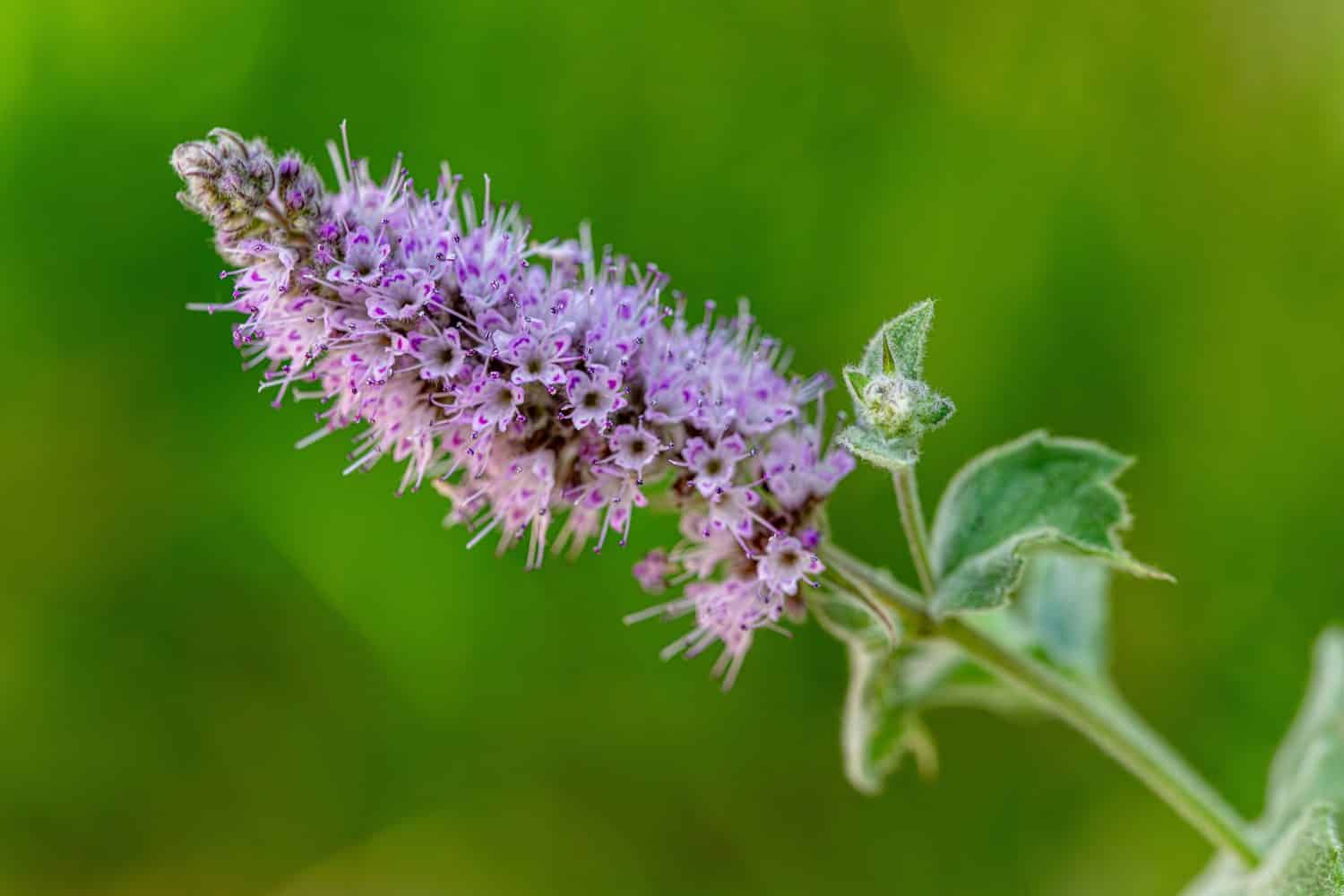
Wild mint has rather tiny flowers that range from white to pink to lavender.
©Levon Avagyan/Shutterstock.com
Unlike most plants, wild mint grows flowers along the stems instead of at the end of branches. Its flowers are small and bell-shaped, and the plant has the classic mint smell.
Best Time to See Wild Mint
This is a summer plant. In the more southern areas of the US, it starts blooming in May and goes into October. In more northern states, the growing season may be a bit shorter, usually from June to September.
Where Wild Mint Is Found
Wild mint lives in much of the US. It’s one of the few mint plants native to the US. It can be found everywhere in the continental US except the southern reaches of the US from Florida to Louisiana. They are also not found in Oklahoma.
How to Identify Wild Mint
The distinctive smell of mint plants helps to identify them from similar-looking plants. Wild mint is different from other mints because it has four-lobed flowers that are symmetrical and on the stem, They’re usually hard to see because they are hidden by leaves.
How Common Is Wild Mint?
Wild mint is very common. It’s native to most of the US, so you can find it anywhere there is moist or wet soil.
3. Common Milkweed (Asclepias syriaca)

Common milkweed flowers are a little more open than swamp milkweed flowers.
©iStock.com/mr_coffee
Like swamp milkweed, common milkweed also has pink flowers. They are usually some shade of pink near the bottom, with the tips being white, pale pink, green, or purple.
Best Time to See Common Milkweed
Common milkweed blooms between June and August. In more southern states, they may bloom as early as May.
Where Common Milkweed Is Found
Common milkweed is found in Canada and the US. It can be found on the entirety of the East Coast except for Florida. Its native habitat stretches all the way west to Texas, Kansas, Missouri, and north of those states. It’s also found in Montana and Oregon in some areas.
How to Identify Common Milkweed
Common milkweed looks a lot like swamp milkweed. The main difference is that common milkweed has wider leaves and less compact flowers. Overall, it’s a less showy plant.
How Common Is Common Milkweed?
It’s a very common and widespread species that grows as abundantly as a weed.
4. Marsh Hedgenettle (Stachys palustris)
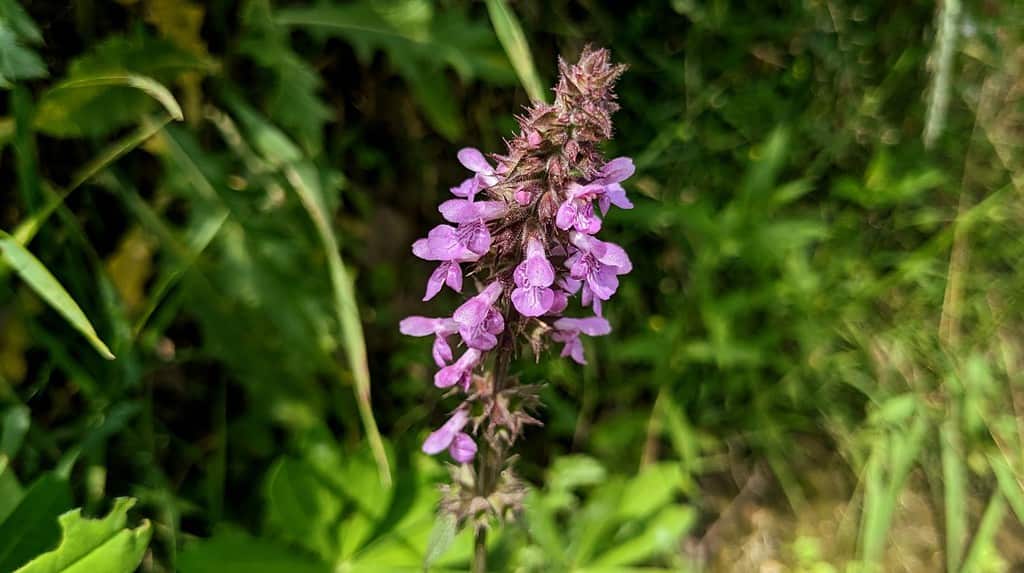
These marsh plants grow beautiful pink and white flowers that catch the eye.
©Natalka De/Shutterstock.com
Marsh hedgenettle is also known as marsh woundwort, clown’s woundwort, clown’s heal-all, or just as hedge-nettle. It’s a herb very attractive to bees. It can also help heal wounds.
Best Time to See Marsh Hedgenettle
These flowers bloom most often between April and August. They’ll often be surrounded by bees when they start to bloom. This means it should be easy to spot the flowers, even though they are fairly small.
Where Marsh Hedgenettle Is Found
Marsh hedgenettle is common throughout most of the northeastern parts of the US. States you can expect to find it include Pennsylvania, Vermont, Wisconsin, Maryland, and Maine.
How to Identify Marsh Hedgenettle
The marsh hedge nettle has flowers that are somewhere between pink and lavender in color. There may be spots on the inside of the lower lip of the flower that are white or dark purple. There are also four stamens under the upper lip that are dark purple. The flowers themselves are irregular and fairly small, measuring less than an inch long. Little hairs may also be found on the flower itself.
How Common Is Marsh Hedgenettle?
Though they aren’t found throughout the entirety of the United States, they are widespread in their natural range. You shouldn’t miss them if you decide to go out and search.
5. Pink Lady’s Slipper (Cypripedium acaule)
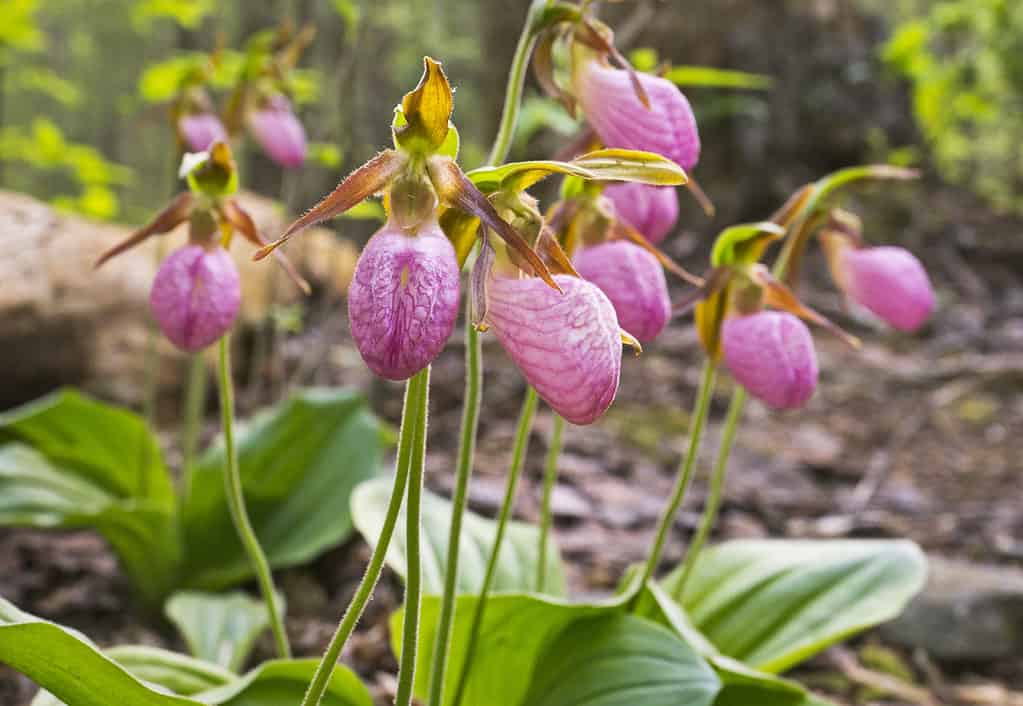
These flowers get their name from their color and the way their shape resembles a shoe.
©iStock.com/wbritten
Pink lady’s slipper is also often known as the moccasin flower. They are part of the orchid family, though they look quite different from orchids you find in the store. Though they are often pink, they may also be brownish purple, or red as well.
Best Time to See Pink Lady’s Slipper
Like many other flowers, these delicate plants bloom the most between May and July. They have a pretty narrow blooming window in the summer, so you’ll have to make sure you take the time to look for them when you’re out.
Where Pink Lady’s Slippers Are Found
Pink lady’s slipper is found anywhere along the East Coast from Georgia to Maine. Up north, it can even be found as far west as Minnesota. They aren’t easy to miss, as long as you know to look for large, mostly pink, flowers.
How to Identify Pink Lady’s Slipper
This orchid is a fairly large flower. The plant can grow up to 15 inches tall, and the flower itself is about two inches long. They are usually a deep magenta or pink, but they can sometimes be a light pink or even white. On lighter flowers, two dark veins are visible on either side of the flower.
How Common Is Pink Lady’s Slipper?
They aren’t the most abundant flower in the area, but they are relatively common to find in the wild.
6. Spreading Dogbane (Apocynum androsaemifolium)
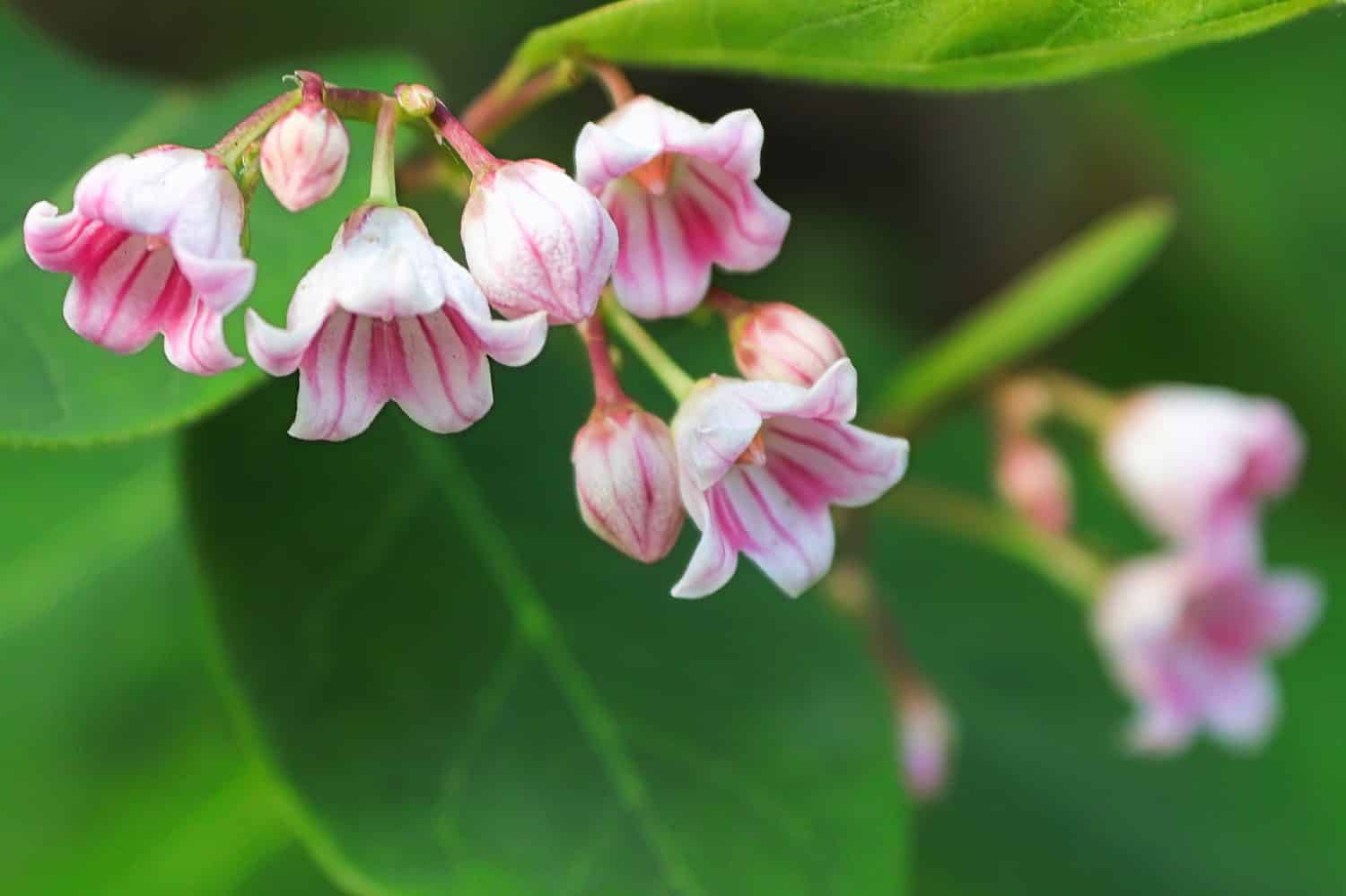
These cute little cups have a mix of pink and white on every flower.
©Amelia Martin/Shutterstock.com
Spreading dogbane is another type of pink wildflower. Despite how pretty it looks, it’s not one you want in your yard if you have curious children or pets, as it’s toxic. It’s also harmful to farm animals, so make sure you don’t have it spreading around your pastures.
Best Time to See Spreading Dogbane
Spreading dogbane blooms anywhere between the middle of June to the middle of August. However, it’s not just the flowers of this plant that are neat. In the fall, it changes color, like trees. In fact, they are one of the first plant species to change colors. The leaves turn a brilliant yellow in early fall.
Where Spreading Dogbane Is Found
Spreading dogbane can be found throughout almost the entire Northern US and Canada. It’s even found in Alaska and Hawaii. The only areas you might not see this plant are in Kansas, Mississippi, Florida, Louisiana, and South Carolina.
How to Identify Spreading Dogbane
Spreading dogbane is a rather branchy plant. Each stem branches multiple times and it can stand up to two feet tall. The stems are red and at the end of most of the branches is a cluster of flowers. The flowers are small, less than a quarter of an inch in size, and are shaped like bells. The flowers are primarily white, but have vibrant pink stripes on them, especially on the inside of the flower. They have a sweet smell that is noticeable anytime you’re near the flower.
How Common Is Spreading Dogbane?
In most of the US, spreading dogbane is very common. Despite being a native plant, some states consider it a nuisance weed because of how quickly it spreads. They enjoy a wide range of habitats as well, including the sides of roads, waste areas, and fields.
7. Large Beardtongue (Penstemon grandiflorus)
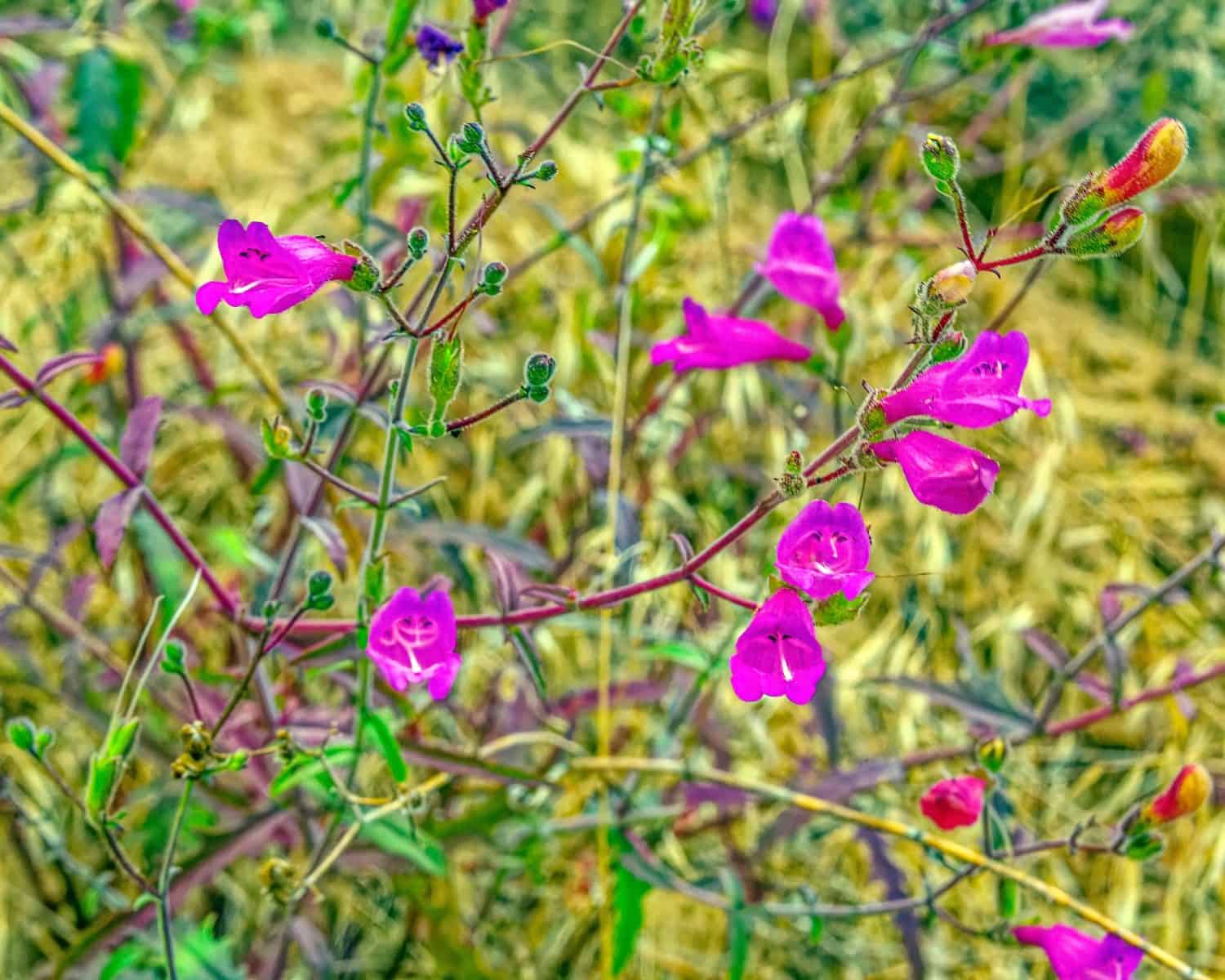
You won’t find many plants that have brighter and more stunning flowers than the large beardtongue.
©Gary Gilardi/Shutterstock.com
Large beardtongues are so-called due to their rather large flowers. Beardtongues are a type of native penstemon that is stunning and sure to catch your eye if the flowers are in bloom.
Best Time to See Large Beardtongue
Large beardtongues are one of the types of pink wildflowers you won’t see often. It only opens up for a few weeks in May or June. You don’t want to miss the chance to see them, so make sure you take the time to get out and explore.
Where Large Beardtongues Are Found
These brilliantly pink wildflowers are found most often in the Midwest and the Great Plains. They can also grow very well in gardens. Strangely enough, there are also a few plants found on the East Coast, specifically in Massachusetts and Connecticut.
How to Identify Large Beardtongue
The flowers on the large beardtongue may come in several different colors. The bright pink is common, but they can also be lavender, purple, magenta, or even blue. The flowers are about two inches long. On the inside of the flower, there are often deep purple veins. The leaves are large and blue-green and are often waxy.
How Common Is Large Beardtongue?
In addition to having a short blooming window, the large beardtongue also isn’t very abundant. In some states, it’s endangered, and it’s hard to find in the wild. Since they are great pollinators, you can plant them in your own yard if you really want a chance to see their brilliant flowers. They are also pretty abundant in Minnesota in the wild.
8. Deptford Pink (Dianthus armeria)
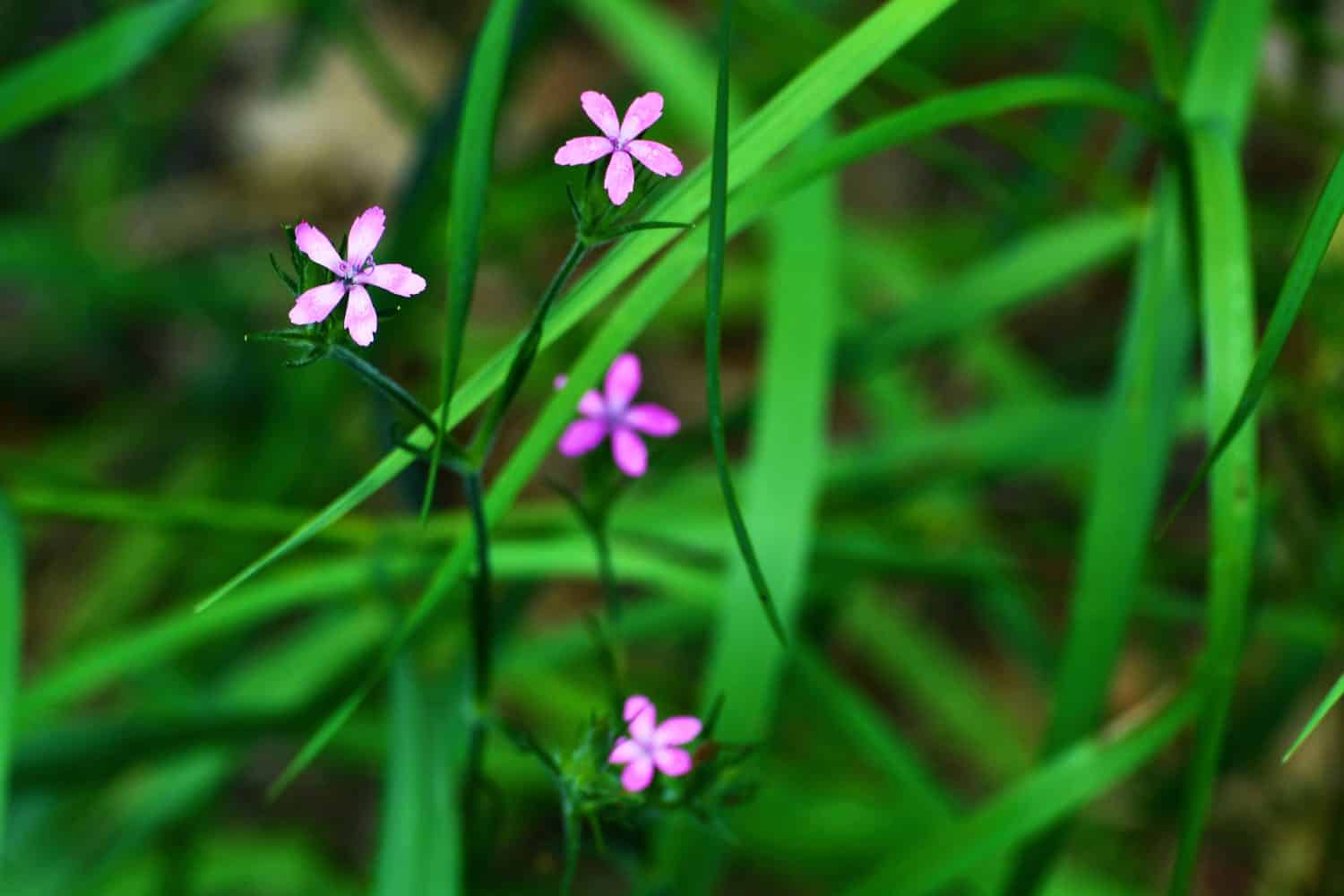
These flowers are bright pink with bright white spots.
©James W. Thompson/Shutterstock.com
Deptford pink flowers aren’t native to the US. They were originally from Deptford, England, but managed to grow in parts of the US quite well.
Best Time to See Deptford Pinks
The best time to see Deptford Pink flowers is between May and October. This is when they are the brightest and boldest.
Where Deptford Pinks Are Found
Deptford pinks are most common along the East Coast, especially in North Carolina. You’re most likely to find it at low and middle elevations around roads, fields, and pastures. It’s less common in coastal areas. It has managed to find a niche in areas where you wouldn’t normally see a lot of flowers, as many other broadleaf perennials can out-compete.
How to Identify Deptford Pinks
Deptford pinks have four to five petals per flower. Each flower is fairly small, less than an inch. The flowers usually grow in clusters, but can also grow by themselves. They are usually deep pink with white spots. Each petal is toothed on the top half and they are slightly fuzzy. The flower petals are fairly narrow compared to the Maiden Pink, which is closely related.
How Common Is Deptford Pink?
They are still somewhat a rare sight outside of the East Coast but are starting to spread and become more abundant throughout the US.
9. Trumpetweed (Eutrochium fistulosum)
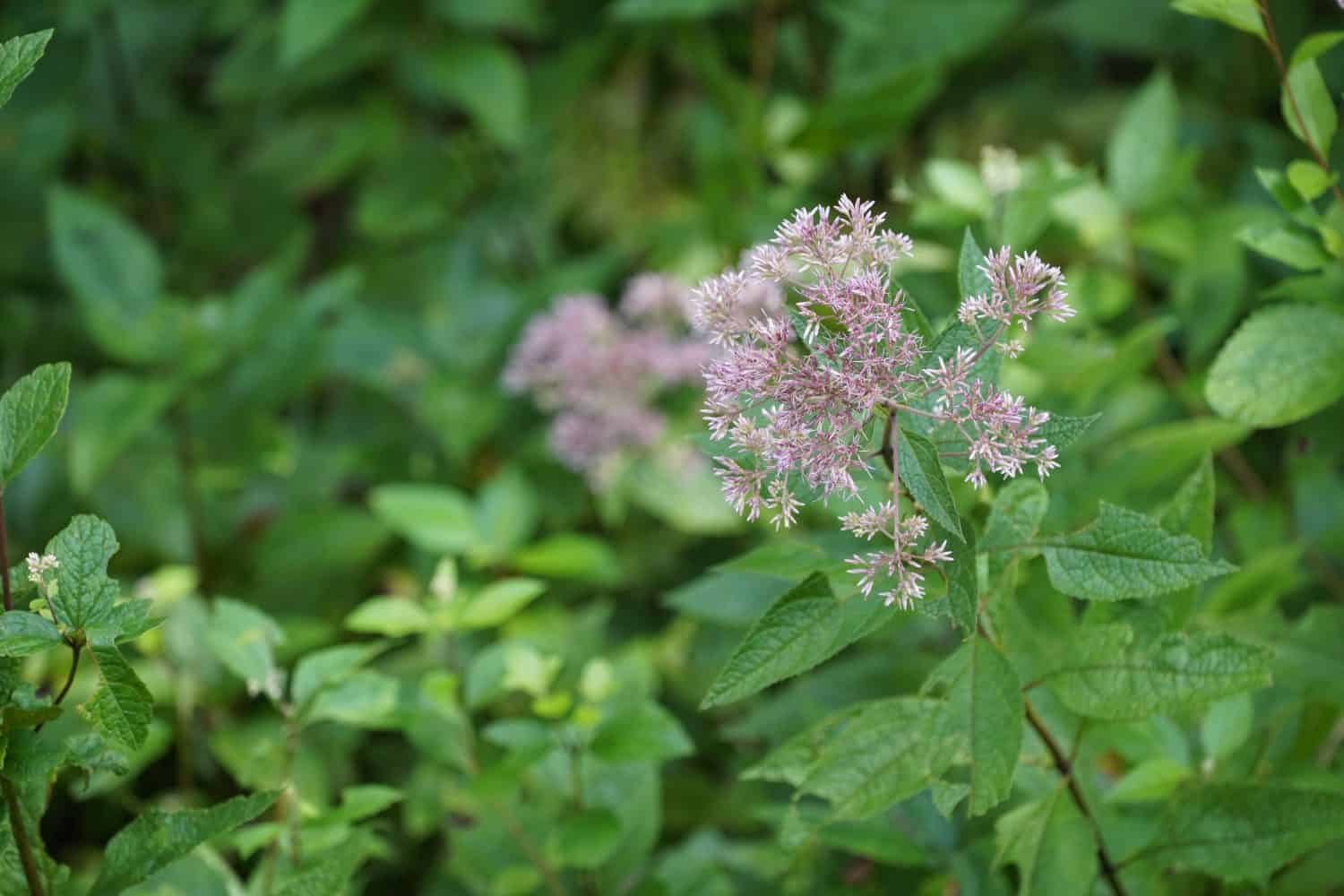
Though it looks a little like spotted Joe Pye weed and belongs to the same family, trumpetweed has a little of its own unique personality.
©Doikanoy/Shutterstock.com
While trumpetweed isn’t toxic, it is bitter, which keeps away many grazers, except deer. It’s also a great flower for pollinators, such as bees, moths, and butterflies.
Best Time to See Trumpetweed
Trumpetweeds bloom most around July through September. First-year plants will flower but tend to have much smaller flowers than older plants.
Where Trumpetweeds Are Found
You will find trumpetweeds in wet, but sunny habitats such as swamps, wet meadows, and thickets. They live primarily along the East Coast, though they have been found spreading to Texas, Kansas, and Missouri. They also tend to avoid the extreme north and south, such as the tip of Maine and the bottom of Florida.
How to Identify Trumpetweed
The main difference between trumpetweed and other species in the Eutrochium genus is the size. While most other species stay around six feet tall or shorter, trumpetweed can easily grow up to 11 feet tall. Leaves also appear in whorls of four to seven, though eight isn’t uncommon. Though still pink, the flowers are usually more of a pale pink, instead of a darker reddish-pink
How Common Is Trumpetweed?
Trumpetweeds are fairly common, and only becoming more so as their range expands. Despite its name, it isn’t actually a weed, as it doesn’t take over in areas it populates.
10. Trailing Phlox (Phlox nivalis)

The plant known as trailing phlox may also be called creeping phlox due to the way it creeps over walls and lawns.
©Labraaten/Shutterstock.com
Trailing phlox makes for the perfect garden plant. It’s relatively low-maintenance. It spreads across the ground, staying low, until it looks almost like a mat. The flowers are fragrant and attract pollinators of all sorts. Even when it’s not blooming, the plant is often vibrant and green.
Best Time to See Trailing Phlox
The flowers bloom quite a bit throughout the year. You can find them in spring and summer, for the most part. However, in most areas, the bloom tends to be earlier, in the spring. The blooms last three to five weeks.
Where Trailing Phlox Is Found
The most common place to find trailing phlox is in the south. It’s found naturally in areas from Virginia to Florida. Though it’s in a limited area, it is native. You can also find it in many gardens, as it does well in Zones 5 to 9 in the US. They prefer rocky areas like outcrops and even the sides of roads.
How to Identify Trailing Phlox
Trailing phlox has bright pink flowers that grow in clusters. The outer edges of the flower tend to be a brighter pink, with a darker patch of pink near the center. Each flower has five petals. Unlike some other phlox species, the petals on the flowers tend to be narrow, instead of wide and broad. It’s also semi-woody, which is a bit different from most other related species.
How Common Is Trailing Phlox?
Trailing phlox is fairly common. It’s hardy, which means it survives even when some other species of phlox cannot. You’ll especially find it crawling over rocks and pavement, as that’s the niche it feels best.
Summary of the Most Amazing Types of Pink Wildflowers
| List | Name | Best Time to See | Where Found | How Common |
|---|---|---|---|---|
| 1 | Swamp Milkweed | Throughout much of the world, including the Midwest and East Coast of the US | In most of the US except in easternmost states | Very common |
| 2 | Wild Mint | Between May and October | Throughout most of the US except from Florida to Louisiana, and Oklahoma | Very Common |
| 3 | Common Milkweed | Between May and October | In the entirety of the eastern US and Canada starting in Texas with the exemption of Florida | Very common |
| 4 | Marsh Hedgenettle | April through August | In the northeastern part of the US and some of Canada | Limited range, but very common inside that range |
| 5 | Pink Lady’s Slipper | May through June | In the easternmost states | Fairly common |
| 6 | Spreading Dogbane | June through August | Almost all of the US and Canada | Very common |
| 7 | Large Beardtongue | May through June | Mostly the plains and Midwest, though they are very abundant in Minnesota | Rare in many states |
| 8 | Deptford Pink | May through October | Throughout much of the world, including the Midwest and east coast of the US | Still sometimes hard to find, but becoming more common |
| 9 | Trumpetweed | July through September | Mostly on the East Coast of the US, though it is starting to expand its range | Pretty common, especially in its native habitat |
| 10 | Trailing Phlox | Mid to early spring | On the southern east coast, most commonly found between the southern tip of Virginia and Florida | Pretty common, especially in areas where other flowers would struggle to survive |
The photo featured at the top of this post is © John Caley/ via Getty Images
Thank you for reading! Have some feedback for us? Contact the AZ Animals editorial team.






